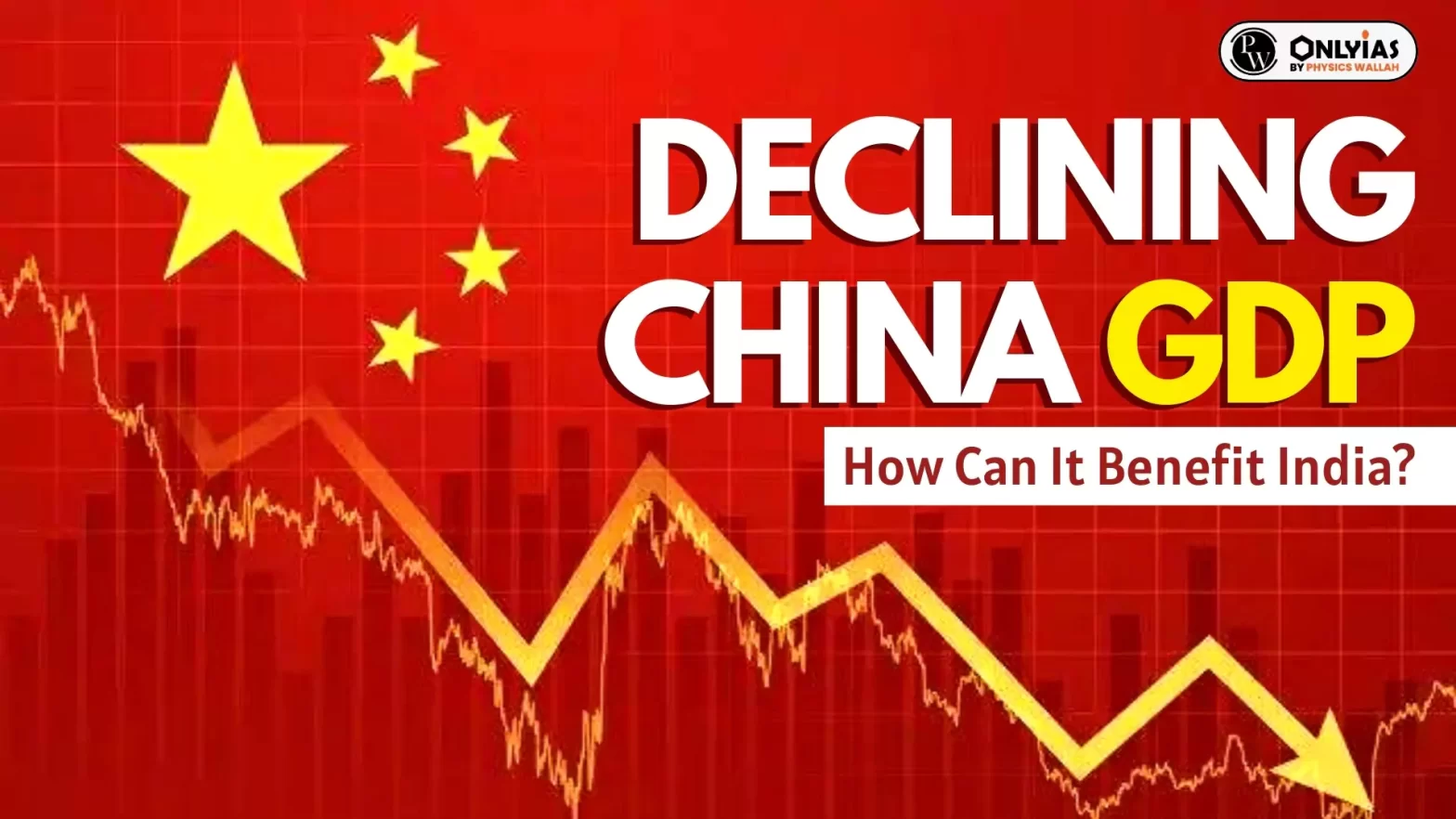How a Slowdown in China Impacts India
Syllabus:
GS-3:
Growth & Development
Focus:
China’s recent economic slowdown, with GDP growth hitting its lowest pace in six quarters, has significant implications for India. This decline has resulted in a sharp fall in Indian exports to China, raising concerns about the long-term effects on India’s trade balance and overall economic stability.
Understanding the China’s Economic Situation:
- Recent Growth Decline: China’s GDP growth in the July-September quarter reached its lowest point in six quarters, raising concerns about the longevity of this slowdown.
- Global Repercussions: The slowdown in the world’s second-largest economy has triggered effects worldwide, influencing various sectors, including global oil markets and India’s spice exports.
- Stimulus Measures: Although the Chinese government announced a stimulus package in September, experts predict that its impact will not be immediate, leading to worries of a long-term downturn rather than a cyclical one.
What is the Evergrande Crisis ?
- Real Estate Sector’s Role: Evergrande was a key driver of China’s post-pandemic economic recovery.
- Market Slowdown: The property market is progressively slowing, leading to reduced demand for new homes.
- Household Wealth Impact: Nearly 75% of household wealth in China is tied up in housing, affecting cash flows.
- Economic Ripple Effects: A collapse of Evergrande could severely impact China’s economy and global commodities and financial markets.
- Global Financial Risk: Economists suggest the overall threat to global financial markets is relatively small.
Recent Economic Reforms in India:
- PM Gati Shakti Scheme: Aimed at enhancing infrastructure efficiency and connectivity by integrating various modes of transport and logistics.
- National Monetisation Pipeline: Focuses on monetizing government assets to boost investment in public services and infrastructure development.
- Labour Codes: Consolidation of existing labour laws into four codes to simplify compliance, improve working conditions, and enhance employee benefits.
- Atma Nirbhar Bharat Scheme: A self-reliant initiative promoting local manufacturing, enhancing MSME support, and encouraging domestic production across sectors.
Direct Effects on India:
- Declining Exports: Indian exports to China plummeted by 23% year-on-year in August, amounting to only $1 billion, the lowest since August 2022.
- Trade Deficit Increase: The sustained decrease in exports has resulted in a significant increase in India’s trade deficit with China, which reached about $4 billion from April to August 2024, constituting approximately one-third of India’s total trade deficit.
- Import Surge: In contrast, imports from China surged to their highest level in August at $10.8 billion, exacerbating the trade imbalance.
Sector-Specific Impacts:
- Top Export Declines: Seven out of India’s top ten exports to China have seen a decline this year. Major sectors affected include:
- Iron Ore: Exports fell from $1.15 billion to $882 million.
- Cotton Yarn: Exports plummeted by 80%.
- Granite and Building Materials: Experienced a 25% drop due to a slump in Chinese construction.
- Petroleum and Vegetable Oils: Only these sectors showed growth, with petroleum exports increasing by 1% to $577 million.
Broader Economic Context:
- China’s Structural Challenges: The slowdown is partly attributed to the collapse of the real estate sector, a crucial growth driver, coupled with rising government debt and declining local infrastructure investments.
- Shift in Growth Model: China’s long-term challenge is to transition to growth driven by domestic consumption rather than heavy reliance on investment and exports. This transition has been a stated economic goal since 2004 but remains to be seen if it can be effectively implemented.
- Concerns in the Global Oil Market: The International Energy Agency (IEA) highlighted that China’s slowdown raises questions about future global oil demand, impacting refining margins for Indian companies like Reliance Industries.
Strategic Opportunities for India:
- Market Diversification: With the decline in exports to China, India has the opportunity to diversify its export markets. By exploring trade relations with other countries, especially in Southeast Asia and Africa, India can reduce reliance on the Chinese market.
- Boosting Domestic Production: This slowdown offers an impetus for India to enhance its domestic manufacturing capabilities. Strengthening local industries can create jobs and reduce the trade deficit with China.
- Innovation and Technology: Emphasising innovation and technology in production processes can increase competitiveness. India can invest in sectors like electric vehicles and renewable energy to align with global demand trends.
Policy Recommendations:
- Trade Policy Reform: The Indian government should consider revising trade policies to support sectors heavily impacted by the slowdown. This includes incentives for exporters to explore new markets.
- Strengthening Bilateral Relations: India should foster stronger trade ties with countries that can fill the void left by decreased exports to China. Strategic partnerships can lead to mutual economic benefits.
- Investment in Infrastructure: Enhancing infrastructure is crucial for supporting export activities. Improved logistics and supply chain management can facilitate smoother trade operations.
Future Implications for India:
- Continued Export Struggles: For the five-month period from April to August 2024, Indian exports to China decreased by $528 million compared to the same period in 2023, affecting a wide array of sectors.
- Need for Adaptation: Indian exporters must explore alternative markets and adapt strategies to mitigate the impacts of China’s economic challenges. This may involve enhancing competitiveness and diversifying export portfolios.
- Monitoring Trends: As the situation evolves, continuous monitoring of China’s economic indicators will be crucial for India to navigate its trade relationship and minimise negative repercussions.
Conclusion:
China’s economic slowdown poses significant challenges for India, affecting trade dynamics and export performance across various sectors. While certain industries manage to adapt and find growth, the broader implications of China’s structural changes will require Indian policymakers and exporters to recalibrate strategies in response to evolving global economic conditions.
Source: Mint
Mains Practice Question:
Discuss the implications of China’s economic slowdown on India’s trade relations and export sectors. How can India adapt to mitigate the impacts of such global economic shifts?
Associated Article:
https://universalinstitutions.com/whats-causing-chinas-economic-slowdown-and-its-global-impact/




